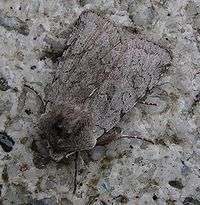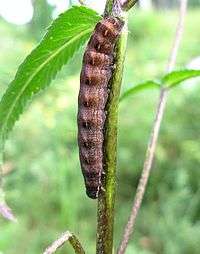Cerastis rubricosa
| Cerastis rubricosa | |
|---|---|
| | |
| Scientific classification | |
| Kingdom: | Animalia |
| Phylum: | Arthropoda |
| Subphylum: | Hexapoda |
| Class: | Insecta |
| Order: | Lepidoptera |
| Family: | Noctuidae |
| Genus: | Cerastis |
| Species: | C. rubricosa |
| Binomial name | |
| Cerastis rubricosa (Denis & Schiffermüller, 1775) | |
| Synonyms | |
| |
The Red Chestnut (Cerastis rubricosa) is a species of moth of the Noctuidae family. It is found in most of Europe, east through the temperate regions of the Palearctic East to Japan. In the north it is found just north of the Polar circle. Southward it is found up to the Mediterranean basin and Turkey.


Description
The wingspan is 32–38 mm.Forewing red brown, varied with grey, sometimes with a purplish-brown tinge; stigmata grey with fine dark outlines; a broad angled median shade; lines all starting from black costal spots; hindwing fuscous grey; fringe grey. Generally distributed in Europe, except Spain, and found in W. Siberia and W. Turkestan. -The form rufa Haw. the usual British form, is almost wholly rufous, and the fringe pink. - mucida Esp. is dark purplish red with the costa and subterminal shade slaty grey; - pilicornis Brahm has the red ground almost obliterated by grey suffusion, the cross lines brownish; of this pallida Tutt is merely an extreme pale form; finally, mista Hbn. is brick red with costa, cross lines, and outer margin grey.[1]
Biology
Adults are on wing from March to May depending on the location.
Larva reddish brown, with dark bands on dorsal segments; dorsal line slightly paler: subdorsal pale yellow, narrow; spiracular line brownish, yellow in front.The larvae feed on the leaves of various plants, including Luzula, Gymnadenia conopsea, Lotus corniculatus, Veronica chamaedrys, Rhinenthus alectorolophus and Orchidaceae species.[2]
References
- ↑ Seitz, A. Ed., 1914 Die Großschmetterlinge der Erde, Verlag Alfred Kernen, Stuttgart Band 3: Abt. 1, Die Großschmetterlinge des palaearktischen Faunengebietes, Die palaearktischen eulenartigen Nachtfalter, 1914
- ↑ "Robinson, G. S., P. R. Ackery, I. J. Kitching, G. W. Beccaloni & L. M. Hernández, 2010. HOSTS - A Database of the World's Lepidopteran Hostplants. Natural History Museum, London.".
| Wikimedia Commons has media related to Cerastis rubricosa. |